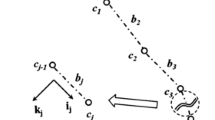Abstract
In this paper, the structural, sensor, and actuator mathematical models of a transelevator are presented; after, the mathematical model with sensor and actuator of the transelevator is obtained by using the combination of the above mentioned mathematical models. The proposed mathematical model is validated comparing the simulation results against the experimental results. Finally, the stability analysis of the aforementioned model is studied.








Similar content being viewed by others
References
Bachrach J, Beal J, McLurkin J (2010) Composable continuous-space programs for robotic swarms. Neural Comput Appl 19:825–847
Celikkanat H, Sahin E (2010) Steering self-organized robot flocks through externally guided individuals. Neural Comput Appl 19:849–865
Chaoui H, Sicard P (2011) Adaptive Lyapunov-based neural network sensorless control of permanent magnet synchronous machines. Neural Comput Appl 20:717–727
Chen C, Inoue Y, Shibata K (2011) Identification of a golf swing robot using soft computing approach. Neural Comput Appl 20:729–740
Chiu C-H (2010) Self-tuning output recurrent cerebellar model articulation controller for a wheeled inverted pendulum control. Neural Comput Appl 19:1153–1164
Christensen DJ, Campbell J, Stoy K (2010) Anatomy-based organization of morphology and control in self-reconfigurable modular robots. Neural Comput Appl 19:787–805
Lee W-P, Yang T-H (2011) Combining GRN modeling and demonstration-based programming for robot control. Neural Comput Appl 20:909–921
Leite D, Ballini R, Costa P, Gomide F (2012) Evolving fuzzy granular modeling from nonstationary fuzzy data streams. Evolv Syst 3(2):65–79
Lemos A, Caminhas W, Gomide F (2011) Fuzzy evolving linear regression trees. Evolv Syst 2(1):1–14
Lewis FL, Dawson DM, Abdallah CT (2004) Control of robot manipulators. Theory Pract. ISBN: 0-8247-4072-6
Lughofer E, Bouchot JL (2011) On-line elimination of local redundancies in evolving fuzzy systems. Evolv Syst 2(3):165–187
Pérez-Cruz JH, Alanis AY, Rubio JJ, Pacheco J (2012) System identification using multilayer differential neural networks: a new result. J Appl Math 2012:1–20
Pérez-Cruz JH, Ruiz-Velázquez E, Rubio JJ, de Alba-Padilla CA (2012) Robust adaptive neurocontrol of SISO nonlinear systems preceded by unknow deadzone. Math Probl Eng 2012:1–23
Rubio JJ, García E, Pacheco J (2011) Trajectory planning and collisions detector for robotic arms. Neural Comput App, online
Rubio JJ, Torres C, Rivera R, Hernández CA (2011) Comparison of four mathematical models for braking of a motorcycle. IEEE Latin Am Trans 9(5):630–637
Rubio JJ, Ortiz F, Mariaca CR, Tovar JC (2011) A method for online pattern recognition for abnormal eye movements. Neural Comput Appl. doi: 10.1007/s00521-011-0784-2
Rubio JJ, Salazar M, Gomez AD, Lugo R (2012) Modeling of the relative humidity via functional networks and control of the temperature via classic controllers for a bird incubator. Neural Comput Appl 21(7):1491–1500
Spong MW, Hutchinson S, Vidyasagar M (2006) Robot modeling and control. Wiley, London. ISBN-13: 978-0-471-64990-8
Villaverde I, Graña M (2011) Neuro-evolutionary mobile robot egomotion estimation with a 3D ToF camera. Neural Comput Appl 20:345–354
Wu Y, Sun F, Zheng J, Song Q (2010) A robust training algorithm of discrete-time MIMO RNN and application in fault tolerant control of robotic system. Neural Comput Appl 19:1013–1027
Acknowledgments
The authors are grateful to the editors and the reviewers for their valuable comments and insightful suggestions, which helped to improve this research significantly. The authors thank the Secretaría de Investigación y Posgrado and the Comisión de Operación y Fomento de Actividades Académicas del IPN and the Consejo Nacional de Ciencia y Tecnología for their help in this research. The third author would like to thank the financial support through a postdoctoral fellowship from Mexican National Council for Science and Technology (CONACYT).
Author information
Authors and Affiliations
Corresponding author
Rights and permissions
About this article
Cite this article
de Jesús Rubio, J., Pacheco, J., Pérez-Cruz, J.H. et al. Mathematical model with sensor and actuator for a transelevator. Neural Comput & Applic 24, 277–285 (2014). https://doi.org/10.1007/s00521-012-1224-7
Received:
Accepted:
Published:
Issue Date:
DOI: https://doi.org/10.1007/s00521-012-1224-7




